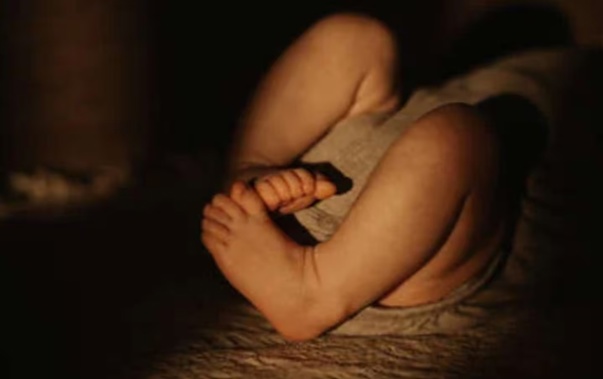
WARNING: this story deals details allegations of significant and fatal child abuse.
- Crown: “no doubt” Michael Topp subjected infant daughter to “repeated, significant trauma and abuse” before the fatal assault
- Defence: Topp admits killing the baby, but it was manslaughter not murder
- Mum of baby girl to give evidence this afternoon
A three-month-old Christchurch girl suffered “repeated episodes of inflicted injuries” including “at least 31 fractures” and two severe head injuries at the hands of her father before he allegedly meted out a final, fatal assault in 2022.
Experts say there is “no doubt” the baby girl was the victim of “repeated significant trauma and abuse” in her short life, which ended in hospital days after she suffered a catastrophic blunt force trauma to her head.
The injuries could only have been caused by her father Michael John Topp “yanking, pulling, smacking, sticking, squeezing, or applying pressure” to her tiny body parts.
Topp admits he caused the injuries that killed his baby girl - but denies the charge of murder. He says the baby’s death was a case of manslaughter, that he had no murderous intent.
A jury in the High Court at Christchurch has this morning heard the full details of the baby’s death, the allegations against Topp and his defence.
Alongside the murder charge, Topp is also facing three further counts of causing his baby grievous bodily harm with intent.
The baby and her mother’s name have been suppressed. However, Topp’s name and his relationship to the victims can be published.
His trial began today before Justice Anne Hinton and a jury. It is expected to run for three weeks.
Crown prosecutor Courtney Martyn gave an opening address this morning, alleging Topp either shook or threw the baby against a soft surface, with “enough violence in his actions to cause her fatal brain bleed”.
She said Topp knew his actions could result in death and that, the Crown said, was murder.
Martyn said the baby’s mother became pregnant early into her “whirlwind” relationship with Topp, who also shares two young children with a previous partner.
Topp and the mother were happy with the pregnancy and soon moved in together.
The relationship at the beginning was “really good” but soon Topp began to change from being “positive and happy-go-lucky” to negative.
It was clear Topp was struggling with his mental health and “feeling overwhelmed” and his partner “actively tried to help him cope” and encouraged him to get professional help.
A short and painful life
The baby was born healthy by c-section and due to complications the mother was being seen by a nurse every day.
In the lead-up to the baby’s death, Topp’s mental health “continued to spiral downwards”.
He was impatient, frustrated, annoyed. He had verbal outbursts and mood swings. He was exhausted and sleep-deprived from working shifts at a manufacturing plant an hour away from Christchurch.
Martyn said the mother often called Plunket and her doctor for advice. As a first-time mother she had concerns and did not hesitate to seek help.
The baby girl cried “for hours” and the mother “often wondered what was wrong with her”.
She suspected colic, but later said it “sometimes felt like [the baby] was in pain”.
The baby became distressed when she was put down to lie flat and, later, when her legs were moved when she was changed or dressed.
Her crying at times was “incessant and sustained”.

The Crown say the baby was murdered by her father. His lawyers say he killed her but it was an accident. Photo / File
Martyn said in November 2022 “things took a turn for the worse” and Topp admitted experiencing panic attacks and “bad thoughts”.
“December was when it simply became too much for Mr Topp,” she told the court.
“Over Christmas [the baby] became more and more unsettled - as did Topp who was worsening over this period.”
From December 28 the baby became increasingly distressed and would only calm when held upright.
Her mother rang the GP who was fully booked. She called the Plunket line who advised her to see an after-hours doctor.
On December 30 a doctor saw the baby, noted she was off-colour and had not been feeding. But he had no concerns other than dehydration.
“But her symptoms waned when she was given fluid and she was fine,” said Martyn.
The doctor saw no need to take any X-rays or CT scans.
When they got home the baby still would not sleep unless she was held. Her mother sat up with her all night.
At 9am Topp took over looking after the baby so she could sleep.
At 9.30am the nurse made her daily visit to the mother.
Topp sent his mother a photo of the baby sleeping peacefully and at 11.20am a video where she was awake, happy and settled.
At 12.25pm he carried the baby into her mother saying she had been feeding and “seemed to start choking, coughing and gagging”.
She had been limp and gurgling for about 10 minutes.
The mother called 111 and paramedics arrived at 12.35pm.
The little life that couldn’t be saved
The baby was rushed to Christchurch Hospital where she was intubated and admitted to intensive care.
Soon after she had two CT scans and two emergency procedures to bore holes into her head to help remove fluid on her brain
Martyn said the scans showed “a severe and extensive head injury along with multiple fractures” to her body.
Doctors concluded the baby would not survive.
She was later taken off life support and died within 10 minutes.

The baby was rushed to hospital but could not be saved. Photo / File
“The Crown case is that the baby’s injuries are not accidental,” said Martyn.
“Rather Mr Topp... was angered by the difficulties settling, he was angered by her failures to feed... he was angered by all of the normal challenges of having a new baby.
“He assaulted her... causing the catastrophic devastating brain injury that killed her.”
A post-mortem examination confirmed the baby died of complications from blunt force head trauma; that she had recent and older bleeding on her brain, both eyes and spinal cord.
She had at least 31 confirmed fractures including her clavicle, lower legs, ribs and four to her left tibia.
“The Crown says this was no accident and not only did Topp kill [the baby] - but that he also subjected her to repeated instances of physical abuse over her short life,” said Martyn.
“There was no natural disease, no description given of any event that could have caused the fatal head injury.
“There was an older significant brain injury that had occurred at least 10 days ago... other breaks... that all had occurred within 10 days.
“Of particular concern, an X-ray of her left tibia showed it was broken in the same place three times. It was broken, it healed, it was broken, it healed, it was broken again.
“[The baby], over the course of her very short life was subjected to repeated physical abuse - and then she was murdered, all of which the Crown says was at the hands of Topp.”
Martyn said the jury would hear from international experts about the baby’s injuries as well as medical professionals involved in her birth, care and death.
The experts would tell the jury the baby “was the victim of repeated” abuse.
“Given the severity and how many injuries there are -there is only one diagnosis that explains it,” Martyn said.
The Crown had “no doubt” the baby was subjected to “repeated, significant trauma and abuse”.
“The final abuse was fatal,” Martyn told the jury.
Defence: Topp admits killing baby but denies murder
Topp’s lawyer made a brief statement to the jury - saying they would hear more about the defence once the Crown case had closed.
She said the baby’s death “affects everyone” close to her - including Topp.
“He loved [her] too,” said Sarah Saunderson-Warner.
“While you’ve heard Mr Topp pleaded not guilty to murder -that doesn’t mean that he’s not accepting responsibility for [her death].
“He accepts that he shook her and that shaking was the cause of her death... He accepts that he caused her death, but defence is that he’s guilty of manslaughter.”
Topp is on trial in the High Court at Christchurch. Photo / George Heard
Saunderson-Warner said while the Crown painted Topp as a man with intent, who knew what he was doing would kill the baby, the defence argued otherwise.
“He did not know that shaking [her] was likely to cause death, and he didn’t consciously run the risk that she would die as a result.
“It was manslaughter, in very simple terms.”
She urged the jury to keep an open mind as to how Topp went “from being a loving father” to killing his little baby.
“To understand that you’re going to need to listen carefully to the evidence about Mr Topp - who he is as a person, what skills he has, what skills he doesn’t have, how he copes and what his mental state was,” she said.
“You’re going to hear evidence that when it came to parenting, Mr Topp was struggling. He lacked the skills, he lacked the coping abilities... to deal with what was going on.
“You’ll hear what he was pressure he was under at the time, you’ll hear about his stress... he had other children to look after, he had a lot going on and that pressure cooker environment was something that he couldn’t cope with.
“He was frustrated and in that state, he shook the baby that he loved. But the defence is that he isn’t a murderer - he did not have a murderous state of mind.
“It will be important for you to take from that evidence an idea of who Mr Topp is, his love for [the baby], but also his inadequacies... his personality, his frustrations, his inability. They will all be relevant in deciding whether he murdered his daughter or whether he caused her death in circumstances where he couldn’t deal with his frustrations, but he didn’t mean to kill her.
Saunderson-Warner acknowledged that hearing about the death of a baby would be difficult and confronting.
“It brings out emotions in all of us, which is natural... I reiterate that you need to approach your job, as judges of fact... without prejudice and sympathy.”
The trial continues.
I suspect a child is being abused. What should I do?
Any abuse of a child is a serious matter. If you suspect a child is being abused it is important that you notify your local police or Oranga Tamariki.
Any concerns about child abuse must be notified early so that an assessment of the child’s safety can be made.
Early intervention by child protection services reduces harm to victims before the abuse has the opportunity to escalate.
They would always rather know about your suspicions and be able to make their own assessment of the child’s safety than not to hear at all.
In an emergency situation - always dial 111.
To find the contact details for your local police click here.
To contact Oranga Tamariki phone 0508 Family or 0508 326 459 or email [email protected]
Anna Leask is a Christchurch-based reporter who covers national crime and justice. She joined the Herald in 2008 and has worked as a journalist for 18 years. She writes, hosts and produces the award-winning podcast A Moment In Crime, released monthly on nzherald.co.nz
This article was originally published on the NZ Herald here.
Take your Radio, Podcasts and Music with you









